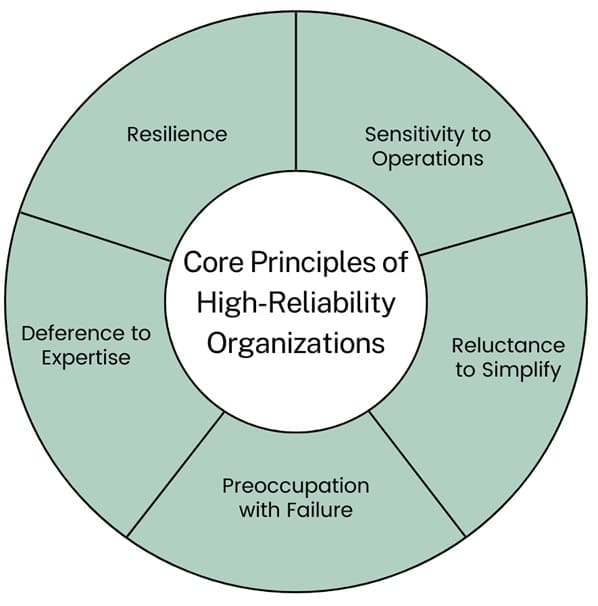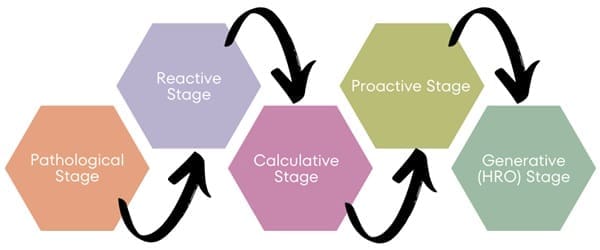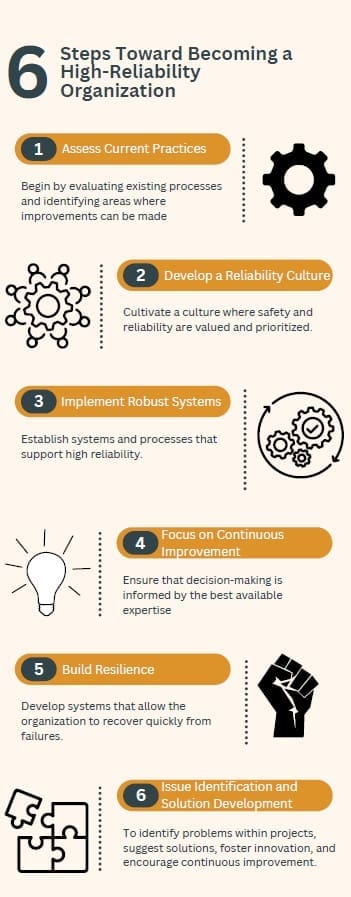High Reliability Organizations (HROs) are organizations that operate in high-risk environments where the potential for catastrophic errors is significant. Despite these risks, HROs consistently achieve their objectives while avoiding critical failures.
They exist in industries like nuclear power, aviation, and petrochemicals. Even minor mistakes in these fields can have severe consequences. These organizations have developed robust systems and processes that enable them to maintain high levels of safety, reliability, and performance.
Table of contents
What are High-Reliability Organizations?
An organization that consistently delivers reliable and safe outcomes in high-risk environments qualifies as a High-Reliability Organization (HRO). These organizations operate in settings where errors could lead to severe consequences. The concept of HROs originally emerged due to their impressive safety records.
Researchers focused on how these organizations managed to avoid disasters even when the stakes were incredibly high. Over time, however, the definition has evolved to emphasize not just the avoidance of failure but the continuous pursuit of reliability.
This continuous improvement mindset is crucial because it recognizes that errors can and do happen. HROs excel at recovering quickly from these errors. They also learn from their mistakes, ensuring they are not repeated.
Evolution of High-Reliability Theory
The theory of high reliability has been a topic of study for decades, particularly in sectors such as energy, aviation, the military, healthcare, and transportation.
Researchers at the University of California, Berkeley, pioneered early work in this field, studying organizations with remarkable safety records. Scholars like Karl Weick and Kathleen Sutcliffe further developed this work. They introduced the concept of “collective mindfulness” as a key characteristic of HROs.
High-reliability theory often contrasts with “normal accident theory,” which takes a more pessimistic view of complex systems. Normal accident theory posits that accidents are inevitable in complex systems, regardless of the precautions taken.
High-reliability theory suggests that organizations can manage even the most hazardous systems safely. This is possible with the right organizational practices.
Core Principles of High-Reliability Organizations

HROs operate based on five core principles that guide their approach to safety and reliability:
- Sensitivity to Operations: HROs maintain a heightened awareness of their operational environment. Employees at all levels are attuned to the nuances of daily operations, identifying what works and what doesn’t. This sensitivity helps prevent small issues from escalating into larger problems.
- Reluctance to Simplify: HROs resist the temptation to oversimplify explanations for problems. They recognize the complexity of their operations and strive to understand the full scope of issues before implementing solutions.
- Preoccupation with Failure: HROs are constantly focused on identifying and learning from errors and near-misses. They treat every failure, no matter how small, as an opportunity to improve their processes and prevent future incidents.
- Deference to Expertise: In HROs, those with the most relevant expertise often take on decision-making authority, regardless of their position within the organizational hierarchy. This delegation ensures that critical issues are addressed by the most knowledgeable individuals. Involving experts in decision-making enhances the effectiveness of the organization’s response to challenges.
- Resilience: HROs are designed to be resilient, with systems in place to recover quickly from failures. They emphasize continuous learning and adaptation, ensuring that the organization remains robust in the face of challenges.
Key Features of High-Reliability Organizations
While there are varying opinions on the specific characteristics that define HROs, there is broad agreement on several key principles:
- Complex Operating Environments: HROs function in environments that are not only physically complex but also socially and politically challenging. These organizations must navigate intricate systems and technologies that inherently carry risks.
- Significant Consequences of Errors: In HROs, mistakes can have severe and far-reaching impacts. This high-risk nature means that trial and error is not a viable learning strategy, as the consequences of failure can be catastrophic.
- Advanced Error Management: To mitigate risks, HROs implement complex processes and technologies designed to manage and minimize errors. They place a strong emphasis on continuous improvement, ensuring that their systems and practices are always evolving.
- Safety Culture: A robust safety culture is central to the success of HROs. This culture is characterized by shared responsibility among leadership and frontline staff. Everyone in the organization is committed to maintaining safety and reliability.
- Adaptability and Resilience: HROs are known for their ability to quickly respond to and recover from failures. This adaptability is essential in environments where unexpected challenges are the norm.
- Collective Mindfulness: One of the most distinctive features of HROs is their collective mindfulness. This refers to an organization-wide awareness of the potential for failure and a constant vigilance against it. In an HRO, everyone is alert to the possibility of errors and is committed to preventing them.
Collective Mindfulness in High-Reliability Organizations

When we talk about collective mindfulness, it is a concept that encompasses several key attributes, all of which contribute to the high reliability of these organizations:
- Preoccupation with Failure: HROs are constantly focused on what could go wrong. They view near misses not as proof that their systems are foolproof but as opportunities to improve and prevent future failures.
- Sensitivity to Operations: In HROs, there is a deep awareness of the complexities and challenges of their operations. Staff at all levels maintain situational awareness, allowing them to quickly identify and address potential issues.
- Commitment to Resilience: HROs prepare for the unexpected by training their teams to be resilient. This means that when failures do occur, they can contain them quickly and prevent them from escalating.
- Deference to Expertise: In HROs, the person with the most relevant knowledge or expertise makes the decisions. This approach prioritizes expertise over organizational hierarchy. It ensures that those best equipped to handle critical decisions are the ones making them.
- Reluctance to Simplify: HROs avoid oversimplifying problems and solutions. They recognize that their systems are complex and that a simplistic approach can lead to unforeseen failures. Instead, they embrace the complexity and encourage diverse perspectives to fully understand and address challenges.
The Path to High Reliability

HROs follow a developmental path toward achieving high reliability. This path typically involves several stages, each marked by a progressively deeper commitment to safety and operational excellence:
- Pathological Stage: At this initial stage, organizations exhibit a mindset of indifference towards safety, focusing only on avoiding detection of failures rather than preventing them.
- Reactive Stage: Here, organizations recognize the importance of safety but only take action after an accident or failure occurs. Safety improvements are reactive rather than proactive.
- Calculative Stage: Organizations at this stage implement systems and processes to manage risks systematically. They begin to quantify and address hazards, but the approach is often rigid and lacks the flexibility needed for high reliability.
- Proactive Stage: Safety leadership and organizational values drive continuous improvement efforts. Organizations anticipate potential risks and take proactive steps to mitigate them before they manifest.
- Generative (HRO) Stage: At this final stage, the organization has ingrained safety and reliability into its culture. The business integrates high standards of Health, Safety, and Environment (HSE) into every aspect.
Steps Toward Becoming a High-Reliability Organization

To transition toward high reliability, organizations should take the following steps:
- Assess Current Practices: Begin by evaluating existing processes and identifying areas where improvements can be made. This includes analyzing past failures and near-misses to understand their root causes.
- Develop a Reliability Culture: Cultivate a culture where safety and reliability are valued and prioritized. This involves engaging all levels of the organization in the pursuit of high reliability and fostering an environment where employees feel empowered to speak up about potential risks.
- Implement Robust Systems: Establish systems and processes that support high reliability, such as regular safety audits, continuous training programs, and effective communication channels.
- Focus on Continuous Improvement: High reliability is not a one-time achievement but an ongoing process. Organizations must commit to continuous learning and adaptation, regularly reviewing and refining their practices to maintain high levels of performance.
- Leverage Expertise: Ensure that decision-making is informed by the best available expertise. This may involve delegating authority to individuals with specialized knowledge or bringing in external experts to provide guidance.
- Build Resilience: Develop systems that allow the organization to recover quickly from failures. This includes establishing contingency plans, conducting regular drills, and maintaining flexibility in operations.
Challenges and Considerations in Developing HROs

The characteristics of HROs are well-documented. However, researchers have gathered less empirical evidence on how organizations evolve into HROs. The journey to becoming an HRO is not straightforward, and there are no simple formulas or checklists that guarantee success. However, several factors have been identified as crucial to the development of high reliability:
- Proactive Leadership: Strong, proactive leadership is essential for fostering a culture of high reliability. Leaders in HROs encourage open dialogue, critical thinking, and continuous learning. They set the tone for the organization, signaling the importance of safety and reliability.
- Supportive Learning Environment: A culture that supports learning and collaboration is vital. In HROs, people openly discuss and analyze mistakes to prevent recurrence. They do not hide or ignore them. This openness to learning from errors is a key component of their success.
- Continuous Improvement: HROs are never complacent. They are always looking for ways to improve their processes, technologies, and practices. This commitment to continuous improvement helps them stay ahead of potential risks and challenges.
- Organizational Learning: HROs place a strong emphasis on organizational learning. This involves not just individual learning but the transfer of knowledge across the organization. Leaders play a crucial role in facilitating this learning by promoting problem identification, knowledge sharing, and reflective practices.
Applications of High-Reliability Concepts
Various sectors have successfully applied the principles of high reliability. Industries like aviation, healthcare, and energy have achieved significant success through these applications. In healthcare, for instance, the application of high-reliability concepts has led to improvements in patient safety and care quality.
Hospitals and healthcare organizations have adopted practices such as crew resource management, root cause analysis, and high-performing team concepts to enhance reliability and reduce errors.
Final Words
High-reliability organisations represent the pinnacle of safety and reliability in environments where the stakes are incredibly high. Their success is not the result of luck or chance but of a deep commitment to continuous improvement, collective mindfulness, and advanced error management.
While the journey to becoming an HRO is challenging and requires significant effort, the benefits are clear: the ability to operate safely and effectively in even the most complex and high-risk environments.
As organizations in various sectors continue to face increasing complexity and risk, the principles of high reliability will become even more critical. By adopting the mindset and practices of HROs, organizations can enhance their resilience, improve their safety records, and ultimately achieve greater success in their respective fields.

About Six Sigma Development Solutions, Inc.
Six Sigma Development Solutions, Inc. offers onsite, public, and virtual Lean Six Sigma certification training. We are an Accredited Training Organization by the IASSC (International Association of Six Sigma Certification). We offer Lean Six Sigma Green Belt, Black Belt, and Yellow Belt, as well as LEAN certifications.
Book a Call and Let us know how we can help meet your training needs.



















